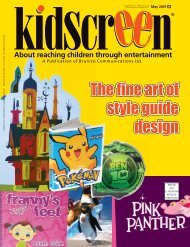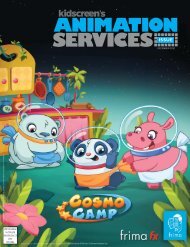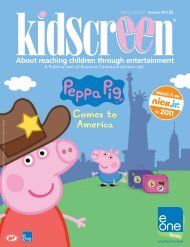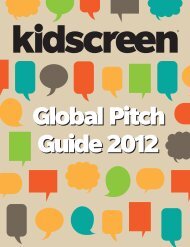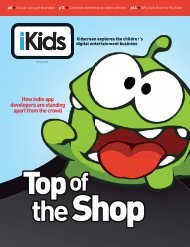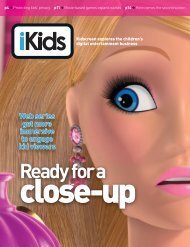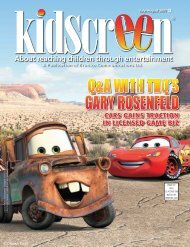Inside - Kidscreen
Inside - Kidscreen
Inside - Kidscreen
Create successful ePaper yourself
Turn your PDF publications into a flip-book with our unique Google optimized e-Paper software.
New Kid in Town<br />
Monster mash<br />
Starting up It’s a monster’s world these days. With Mind Candy’s Moshi Monsters social networking<br />
platform scooping up its 50 millionth user and a range of consumer products deals, it’s<br />
hard to refute that customizable kid-driven social games can be scarily successful. And UK-bred<br />
internet entrepreneur Dominic Williams has taken note, carving out his own social educational<br />
game, Fight My Monster. Despite the same online platform, country of origin and noun in its<br />
title, he insists it is defi nitely diff erent from Moshi in that it’s targeting the boys market. Williams<br />
saw a void left in Moshi Monsters’ predominantly girl-skewing wake and opened the doors to his<br />
virtual world in January. The website has since garnered more than 150,000 users and is monetizing<br />
through a subscription model ahead of expectations. It’s also caught the eyes of angel<br />
investors, including European gaming entrepreneur Dylan Collins.<br />
You’ve got males “I’ve been an entrepreneur for 15 years and have four young sons, so I’ve seen<br />
the void in the boys market and the need for something for those who graduate from Club Penguin,”<br />
says Williams. Fight My Monster is essentially a virtual trading card game that uses customizable<br />
monsters. Kids create their own monster-themed cards (fi ve million have been generated to date)<br />
that can be traded, bought and sold using virtual currency, or used in combat against one another.<br />
The inherent competitive nature of the world speaks directly to boys. “Designing for them is diff erent,”<br />
contends Williams. “For one, there needs to be a level of competition, and boys also marvel<br />
in obtaining objects of power that help them get stronger.” Those gaming elements have attracted<br />
a predominantly seven to 12 male user base (80%) who become friends, build tribes and socialize.<br />
Next moves With a US$8 monthly subscription model in place, Fight My Monster (also the<br />
name of Williams’ company) is charting a course to grow its membership to one million by the<br />
end of this year. To get there, the 10-person operation is banking on TV and web advertising, as<br />
well as expansion into markets outside the UK. “There are seven million kids in the UK and 35<br />
million in the US—we have only scratched the surface,” says Williams. While the brand will be<br />
trailing Moshi Monsters’ move into the US, offl ine merchandise is not part of the near future.<br />
For now, Williams is focused on adding educational mini games to the website and making sure<br />
he feeds the needs of his niche demo. After all, he has a discerning audience at home to keep him<br />
in check. –Wendy Goldman Getzler<br />
32 July/August 2011<br />
TechWatch Keeping an eye on the gadget scene<br />
TheDigits<br />
Numbers that speak volumes<br />
about kids and technology<br />
An artwork-based study from UK researcher<br />
Latitude found that more than<br />
20%<br />
of kids wanted<br />
verbal/auditory controls<br />
on their computers, and<br />
another 15% asked for<br />
touchscreen interfaces (Latitude)<br />
In the same study,92%<br />
of children in the US, Europe<br />
and Australia are more<br />
interested in the process of<br />
interactivity itself rather than any<br />
real-world outcomes. (Latitude)<br />
45% of parents play<br />
computer and video games with their kids<br />
on a weekly basis—a 9% jump since 2007.<br />
(The Entertainment Software Association)<br />
Mobile subscribers ages 12 to 17 watched<br />
more than seven hours<br />
of mobile video a month last year, compared to<br />
roughly four hours for the general population.<br />
(Nielsen)<br />
Don’t believe everything you hear—<br />
American youth are watching<br />
more TV than ever, with the rate<br />
up 6%<br />
over the past fi ve years. (Nielsen)<br />
Jump-starting the kids tablet market<br />
What it is<br />
Educational toy designer LeapFrog<br />
Enterprises is diving into the tablet market<br />
with the offi cial release of the LeapPad, a<br />
US$100 personalized touchscreen learning<br />
tablet designed for kids ages four and up.<br />
How it works<br />
The fi ve-inch tablet holds 2GB of memory,<br />
more than 100 learning-based games and<br />
apps, and a camera, microphone, video<br />
recorder and stylus. Kids can also customize<br />
interactive book content according to their<br />
skill level and tell stories in a Disney-themed<br />
animation studio. The story studio allows kids<br />
to create up to 27,000 different tales using<br />
photos, artwork and narration.<br />
What it means<br />
Some parents may get their iPads back once<br />
the LeapPad offi cially hits retail in mid-<br />
August. The tablet is specifi cally designed<br />
to offer educational and customizable<br />
experiences at a fraction of the price of<br />
popular tablets, meaning LeapFrog may<br />
have hit a sweet spot in terms of what kids<br />
are craving digitally and what parents are<br />
willing to spend.<br />
Photo: LGEPR








